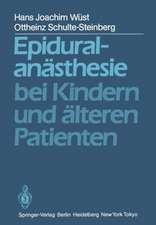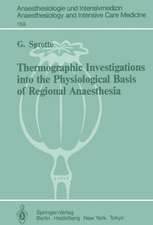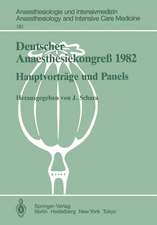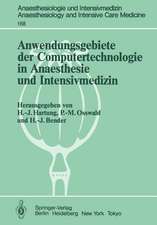Personalized Anaesthesia: Targeting Physiological Systems for Optimal Effect
Editat de Pedro L. Gambús, Jan F. A. Hendrickxen Limba Engleză Paperback – 5 feb 2020
Preț: 765.28 lei
Preț vechi: 805.56 lei
-5% Nou
146.43€ • 152.89$ • 121.19£
Carte disponibilă
Livrare economică 15-29 martie
Specificații
ISBN-10: 1107579252
Pagini: 400
Ilustrații: 33 b/w illus. 87 colour illus. 27 tables
Dimensiuni: 189 x 246 x 15 mm
Greutate: 0.68 kg
Editura: Cambridge University Press
Colecția Cambridge University Press
Locul publicării:New York, United States
Cuprins
Foreword; Introduction; Part I. Basic Principles: 1. Principles of quantitative clinical pharmacology Pedro L Gambús and Sebastián Jaramillo; 2. Pharmacokinetic and pharmacodynamic modeling in anaesthesia María J. Garrido and Iñaki F. Trocóniz; 3. Drug interactions: additivity and synergy among anaesthetic drugs Jacqueline A. Hannam and Timothy G. Short; 4. Covariate analysis in clinical anaesthesia Luis I. Cortinez and Brian J. Anderson; 5. Signal analysis and response measurement Umberto Melia, Erik W. Jensen and José F. Valencia; 6. Application of PKPD and signal analysis to drug administration in anaesthesia Ross R. Kennedy; Part II. Targeting Effects: 7. Hypnotic effect: inducing unconsciousness and emergence from anaesthesia Sergio Vide, Catarina Nunes and Pedro Amorim; 8. Analgesia: effects on response to nociceptive stimulation Emmanuel Boselli and Mathieu Jeanne; 9. Personalized sedation and analgesia Michael M. Beck, Jeffrey B. Horn and Ken B. Johnson; 10. Respiratory depression Malin Jonsson Fagerlund; 11. Immobility Klaus T. Olkkola and Douglas J. Eleveld; 12. Effects on brain function Neus Fabregas and Adrian W. Gelb; 13. Targeted and individualized perioperative medicine for cognitive dysfunction Pauline Glasman, Alice Jacquens and Vincent Degos; 14. Cardiac and hemodynamic function Kai Kuck, Natalie Silverton and Michael K. Cahalan; 15. Effects of anaesthesia on thermoregulation Oliver Kimberger; 16. Effects of perioperative management on kidney function Xavier Borrat and Jordi Mercadal; 17. Effects on liver function Andre M. De Wolf and Jan F. A. Hendrickx; 18. Effects on fluid balance Robert G. Hahn; 19. Ventilation during general anaesthesia Lluís Gallart; 20. Epilogue: artificial intelligence methods Sebastián Jaramillo, José F. Valencia and Pedro L. Gambús; Index.
Descriere
Personalized Anaesthesia presents a modern vision of anaesthesia. Integrating technology and knowledge from leading experts in the field, this book will change the way anaesthesia is both taught and practiced. Modern practice requires the anaesthetist to provide patient-specific management. This is the first resource to be organised by the desired physiological effect, rather than by drug groupings, explaining how physiological changes can be produced and controlled according to the characteristics of each patient and the particular surgical context. The book integrates physiology, pharmacology and technology and applies these concepts in a systematic manner to each homeostatic system. This will optimise drug titration, effect quantification and decision making in anaesthesia practice to match the needs of the individual patient. Complex mathematical and scientific concepts are explained using accessible text, colour illustrations throughout and graphs. This is an essential text for any consultant or trainee working in anaesthesia.





















